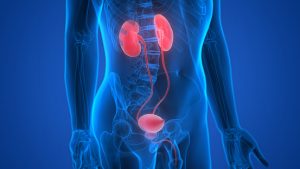
It can occur in both males and females and can develop at any age. However, those over 60 are considered to be at higher risk. Age is a significant risk factor owing to the fact that many processes that can possibly obstruct urine flow occur more frequently at advanced ages.
Causes of obstructive uropathy
Obstructive uropathy causes depend on a variety of factors and at which level the obstruction occurs. The urinary system is comprised of several structures that aid the flow of urine, including the ureters, bladder, and urethra.
Obstruction may occur due to following:
- Bladder stones
- Kidney stones
- Benign prostatic hyperplasia (enlarged prostate)
- Bladder or ureteral cancer
- Colon cancer
- Cervical cancer
- Uterine cancer
- Metastatic cancer
- Scar tissue that occurs inside or outside of the ureters
- Problems with the nerves that supply the bladder (neurogenic)
- Blood clots
- Pelvic fracture
- Disease of the digestive tract
Symptoms of obstructive uropathy
Obstructive uropathy symptoms often depend on the degree and speed in which they present. Pain is the most common symptom of obstructive uropathy, and the pain will appear in different areas based on the area affected. For example, obstruction in the upper ureteral region may cause flank pain or tenderness, while lower ureteral obstruction can cause pain that radiates to the ipsilateral (same side) testis or labium.
Pain can be minimal or even completely absent with partial obstructive uropathy, however, a complete obstruction may lead to severe pain that induces nausea and vomiting. Typically, most people with obstructive uropathy have a decreased bout of expelled urine, as only one kidney may be blocked. You would require both kidneys to be affected to experience complete urine outflow obstruction.
The following are additional symptoms that may be seen with obstructive uropathy:
- Fever
- Weight gain or swelling (edema)
- Urge to urinate often
- Decrease in the force of urine stream
- Dribbling of urine
- Feeling of incomplete bladder emptying
- Need to urinate more often at night (nocturia)
- Decreased amount of urine
- Blood in urine
- Recurrent urinary tract infection (UTI)
- New-onset or poorly controlled hypertension (secondary to obstruction and increased renin-angiotensin)
- Acute and chronic renal failure
How to diagnose obstructive uropathy?
When seeing your doctor, they will get a full history of your presenting symptoms. This will often include documenting how often you urinate, the level of flow, and if you are experiencing any pain. During the physical exam, a visual expectation will likely take place to test if the areas of your kidneys and lower abdomen have any pain to touch.
In almost all cases, additional diagnostic tests will have to take place to get a better idea of where the obstruction is in the urinary tract. But first, some general tests such as a urinalysis and bloodwork will be taken to look for obstructive uropathy clues. Your kidneys play a vital role in the balance of electrolytes and the elimination of various toxins. If you are found to have unusual levels in these initial tests, immediate hepatization may be required.
A bladder catheterization is often done if urine output is diminished, if there is suprapubic pain, or if there is a distended bladder. This helps to restore a normal flow of urine. This test can also be used to determine if there is a urethral obstruction, as it would be difficult to pass the catheter up to the bladder in this case.
A voiding cystourethrography (VCUG) can be done to visualize a person’s urethra and urinary bladder while a person urinates. It involves the use of radiocontrast material and x-ray to see if there is any backflow of urine. While more commonly done in children to diagnose anatomic or congenital abnormalities, it can also be used on adults to help diagnose urethral stricture.
Other diagnostic tests for the diagnosis of obstructive uropathy may include:
- Helical CT: Often without contrast agents, it is often considered the first step in imaging before x-rays by many physicians.
- MRI: When it is available, can provide a more detail image of the urinary system looking for obstruction.
- IV pyelography (IVP): Can help define the extent and anatomy of obstruction.
- Invasive pyelography: Defines the extent of obstruction without depending on renal function, but may be considered too risky for use in some patients.
- Ultrasonography: Can help identify hydronephrosis.
How to treat obstructive uropathy?
Alleviating the obstruction is the main goal when seeking treatment for obstructive uropathy. The use of surgery instrumentation, like an endoscopy, or drug therapy, such as using hormone therapy for prostate cancer, are all valid ways of obstructive uropathy treatment. But therapy will depend on the kind of obstruction found after diagnostic testing.
The use of stents in the renal pelvis may provide short-term symptom relief. A Foley catheter to help drain the bladder can also be deemed useful in acute situations. However, simply draining the bladder is considered short-term relief, as complete resolution of obstructive uropathy will often require surgery.
Prognosis of obstructive uropathy
The good news is that most causes of obstruction can be corrected, however, not seeking treatment as soon as symptoms of obstructive uropathy present itself can lead to irreversible renal damage. If an obstruction is diagnosed and repaired rapidly, kidney damage is less likely. If the obstruction is severe, damaging both kidneys, you may need dialysis or even a kidney transplant.
Related: Bladder stones: Diet tips, treatment, prevention and natural remedies